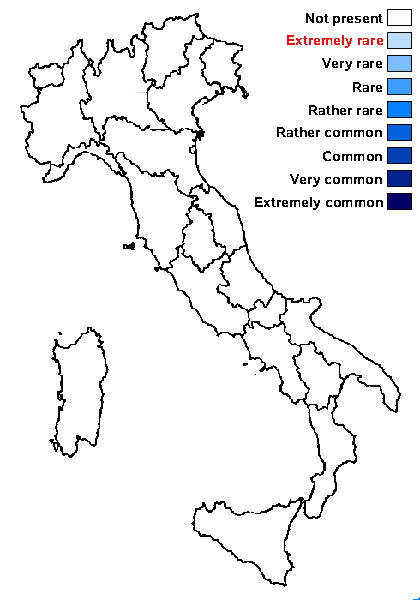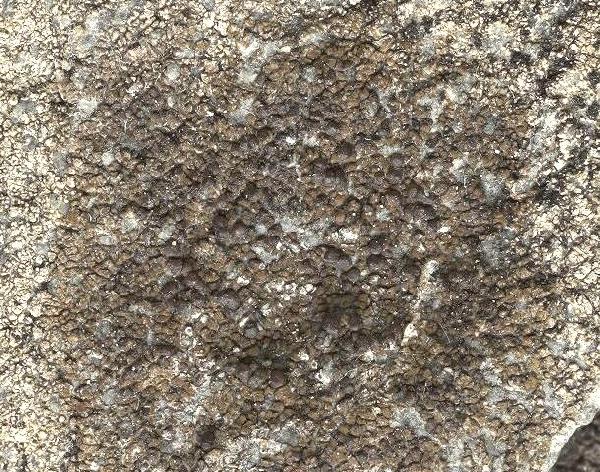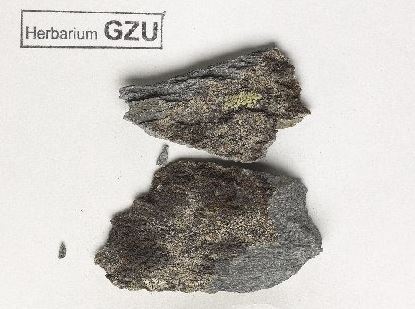Protoparmelia loricata Poelt & Vězda
in Vězda, Lich. Sel. Exs.i, 92: 5 (nr. 2292), 1989.
Synonyms:
Distribution:
Description: Thallus crustose, episubstratic, pale brown, areolate, poorly delimited, 2-3 cm wide, without a distinct prothallus, parasitic on the thalli of Lecanora umbrosa. Areoles rounded to subangular, convex, 0.3-0.5(-1.2) mm wide, with a 30-60 µm thick phenocortex. Apothecia cryptolecanorine, dispersed to aggregate, adnate, 0.5-1 mm across, with a soon convex to globose, reddish brown, shiny disc and a very soon excluded thalline margin. Proper exciple of conglutinated, branched hyphae, not forming a cupula below the hypothecium; epithecium diffuse pale brown, 15-18 µm high; hymenium colourless, c. 70 µm high; paraphyses coherent, branched in upper part, rarely anastomosing; hypothecium colourless, 40-60 µm high. Asci 8-spored, clavate, approaching the Lecanora-type, with a well-developed amyloid tholus and a distinct, non-amyloid axial mass. Ascospores 1-celled (overmature spores rarely 1-septate), hyaline, oblong-ellipsoid to ovoid with rounded ends, 10-15 x 5-8 µm. Pycnidia dark, semi-immersed. Conidia straight, 7-12 x 1-1.5 µm. Photobiont chlorococcoid. Spot tests: cortex and medulla K-, C-, KC-, P-, UV-. Chemistry: thallus without lichen substances. Note: extremely rare on shaded, steeply inclined to vertical faces of basic siliceous rocks with a low content in calcium (e.g. amphibolite); only known from the Eastern Alps (Austria) and the Karakorum: to be looked for in the Italian Alps.
Growth form: Crustose
Substrata: rocks
Photobiont: green algae other than Trentepohlia
Reproductive strategy: mainly sexual

Predictive model

Modified from the original at: https://gzu.jacq.org/GZU000286332
GZU 000286332 - Poelt,J. & Türk,R. Vězda, A.: Lichenes Selecti Exsiccati 2292 - Austria / Tirol — 0.88333° / 0° Label Tirolia orientalis, alpes dicti "Hohe Tauern", in valle "Umbaltal" ; Alt. 1900 m - 1950 m Habitat In lateribus saxorum schistosorum australi-occidentem versus spectantibus

Modified from the original at: https://gzu.jacq.org/GZU000286332
GZU 000286332 - Poelt,J. & Türk,R. Vězda, A.: Lichenes Selecti Exsiccati 2292 - Austria / Tirol — 0.88333° / 0° Label Tirolia orientalis, alpes dicti "Hohe Tauern", in valle "Umbaltal" ; Alt. 1900 m - 1950 m Habitat In lateribus saxorum schistosorum australi-occidentem versus spectantibus
Growth form: Crustose
Substrata: rocks
Photobiont: green algae other than Trentepohlia
Reproductive strategy: mainly sexual

Predictive model

Modified from the original at: https://gzu.jacq.org/GZU000286332
GZU 000286332 - Poelt,J. & Türk,R. Vězda, A.: Lichenes Selecti Exsiccati 2292 - Austria / Tirol — 0.88333° / 0° Label Tirolia orientalis, alpes dicti "Hohe Tauern", in valle "Umbaltal" ; Alt. 1900 m - 1950 m Habitat In lateribus saxorum schistosorum australi-occidentem versus spectantibus

 INDEX FUNGORUM
INDEX FUNGORUM
 GBIF
GBIF


